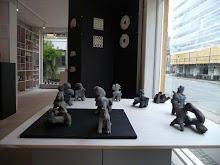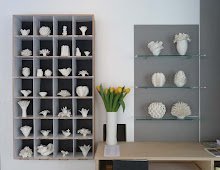


GRAVITATION
Esben Klemann DK
Exhibition March 29 marts - April 28 2012
CLICK IMAGE = LARGE FORMAT + DIA SHOW
Esben Klemann's core area of expression is clearly defined by his interest in architecture, construction and material, – a constant desire to further the development of process is the main importance in his finished pieces.
Esben works freely with architectural pieces for public space and exhibition.
 Always challenged by the characteristic qualities of the material and a desire to test limits of ability - in concrete or ceramics, he is 'plain-curious' and possesses a strangely defined, – and 'probably therefore interesting' - inclination for 'space-narrative'.
Always challenged by the characteristic qualities of the material and a desire to test limits of ability - in concrete or ceramics, he is 'plain-curious' and possesses a strangely defined, – and 'probably therefore interesting' - inclination for 'space-narrative'. Esben Klemann was educated at the Royal Danish Art Achademy in Copenhagen.
He is known for his remarkable sculptural and architectural art work.
 Two Concrete Barriers, Vanløse Culture Centre – Entrance at Paschal, Denmark A/S, AArhus 2010 – Concrete Element, Bornholm Art Museum 2009 -'Step Elements' Eventyrhaven Odense County 2008 – Concrete Elements, Technology Institute, Tåstrup - 'The Bank' outdoor ceramic relief at parking building, Miami USA 2007
Two Concrete Barriers, Vanløse Culture Centre – Entrance at Paschal, Denmark A/S, AArhus 2010 – Concrete Element, Bornholm Art Museum 2009 -'Step Elements' Eventyrhaven Odense County 2008 – Concrete Elements, Technology Institute, Tåstrup - 'The Bank' outdoor ceramic relief at parking building, Miami USA 2007 Recent exhibitions: 'Sculpture by the Sea' Århus 2011, Solo Exhibition, Agallery and 'Across' Tappehallerne Carlsberg, København 2010.
2012 – Honorary Award, The Arts Foundation of 1973 for painters and sculptors – The Danish National Art Foundation, Fine Art Department
 GRAVITATION by Esben Klemann – About my work:
GRAVITATION by Esben Klemann – About my work: ” I am basically open for all means of work, that so to say 'work'. The sum of my experiences throws ideas into space and challenges me to give them physical bodies, - that will work. They continuously materialize in my studio, and wait there in heaps, while I think, rethink and decide, whether I will work further with the idea. If positive, I make a couple of related small works, a kind of test balloons, and from there I escalate in size and number. This way I build up my spacial 'form-curve' by trying, looking and retrying...
 This way I challenge the GRAVITATION in ceramic pieces, where I anyway do things that apparently can not be done. Because it is ALWAYS interesting – ceramics or not.
This way I challenge the GRAVITATION in ceramic pieces, where I anyway do things that apparently can not be done. Because it is ALWAYS interesting – ceramics or not. I cast plastic movements in margarine boxes or fix string in sharp squares; knock stamps into clay blocks and freeze movement by slip-casting into the void...
I intend keeping a certain speed in the 'art production', because I tell myself that boredom during work is directly readable in the finished work. Like trying to figure it out too much, causes laziness, fear and lack of fantasy.
 You can call my work theme-less or abstract, or you can call it language of form, consequently communication by making artistic touched spaces and objects, it injects vitality onto things as a contrast to the ordinary.
You can call my work theme-less or abstract, or you can call it language of form, consequently communication by making artistic touched spaces and objects, it injects vitality onto things as a contrast to the ordinary.  A piece on the floor works differently from a piece at the wall - likewise it is a great difference making an object for an exhibition or building a piece in a specific location.
A piece on the floor works differently from a piece at the wall - likewise it is a great difference making an object for an exhibition or building a piece in a specific location.When I work with the space between ceiling and wall, I get into an area, where often a stucco is placed. This way my work collides with the public expectation of a sculptural manipulation at this place, that may be more in direction of a Roman ornament or fluctuating flower decorations. This way I attack peoples memorized conception of how stucco looks like and at the same time sculpturally play with the space at places, where otherwise room is only left for art pieces on window-sills, flat on walls or small size pieces on little shelves.
In public spaces I usually work with the concrete element, because it is often this material, that forms the architectural frame for people. Concrete is cheap, robust and flexible – but unfortunately mainly used in squares with flat sides. By reshaping I show other possibilities to demonstrate, how a concrete element can act and look. I have made copies of the stop-blocks, that typically stand before road work in cities. A concrete block, that is applied a relief, is beautiful. Furthermore it has flexibility as the traditional mobile concrete block yet liberated from the pedestal of the traditional sculpture. It is natural to move the concrete block using it in new connections.”
www.esbenklemann.dk








































































































